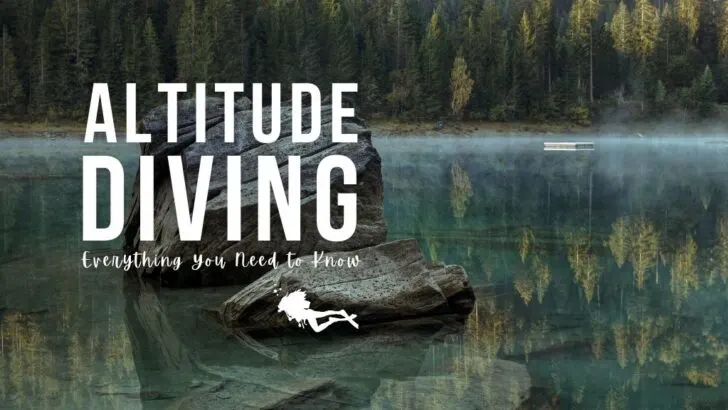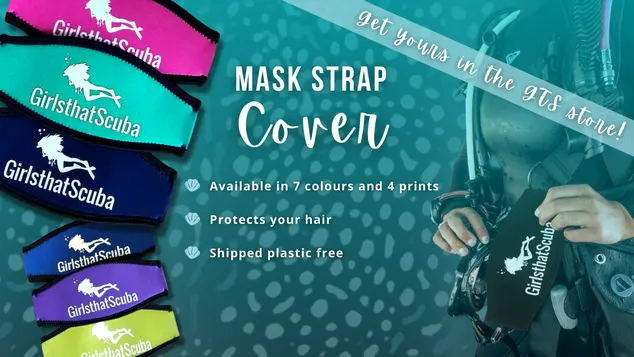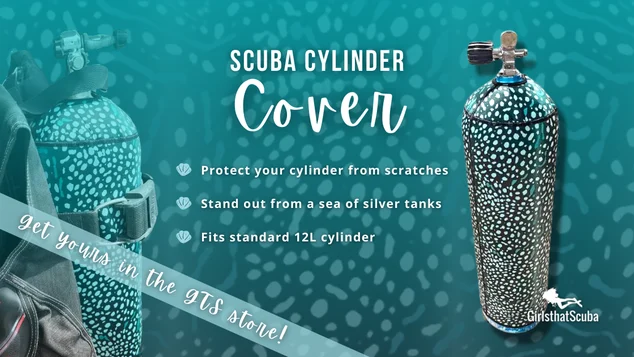Altitude diving opens up a whole new world of dive sites to explore, even when you’re far from the coast. Dive sites at altitude are often overlooked, meaning you can visit waters few others ever experience.
Altitude dive sites offer incredible visibility and a range of underwater topographies. But there’s more to it than just unique underwater environments. Whether you surface to a backdrop of snowy mountains or luscious forests, the experience is incredible. It definitely makes a change from your typical shorelines!
Of course, diving at altitude isn’t without risks, and there are some extra safety precautions to consider. For many divers though, the crystal-clear waters and spectacular scenery are worth it.
Here, we’ll dive a little deeper into the world of altitude diving and highlight some top altitude dive sites. Whether you’re planning an altitude diving holiday or you’re just curious, you’re in the right place!
What is altitude diving?
Technically, altitude diving is any diving conducted 300 to 3,000 metres (1000 to 10,000 feet) above sea level. But what’s the big deal? It all comes down to atmospheric pressure.
As divers, one of the first things we learn is that the pressure underwater is greater than it is at the surface. Underwater, the increased pressure means our tissues absorb more gases, like nitrogen and oxygen.
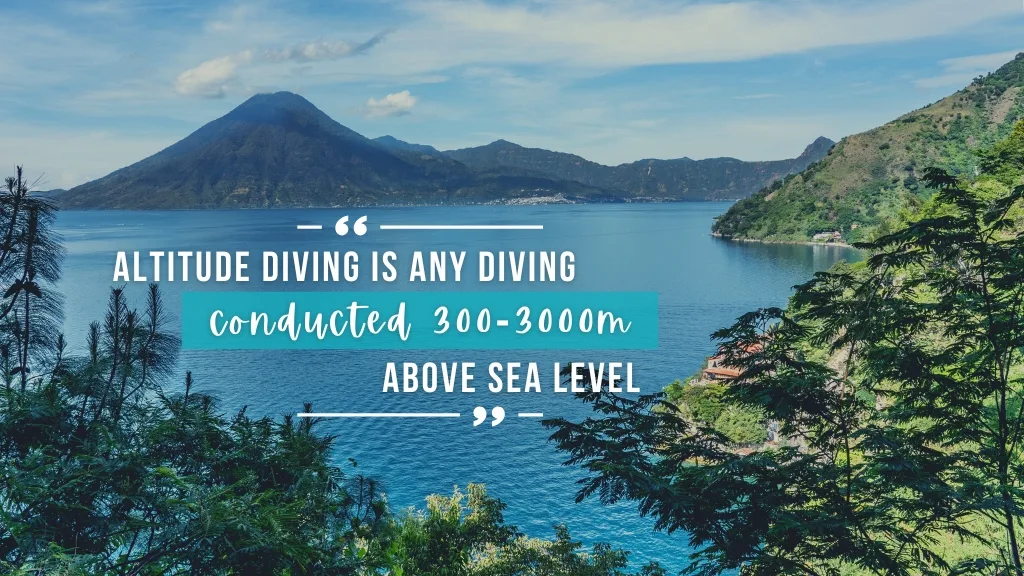
We ascend slowly from dives to let these gases leave our tissues slowly. During ascent, we also pause at 5m (15 feet) for 3 minutes – AKA the safety stop. This is an added precaution that allows extra time for gas to leave our tissues slowly.
If we ascend too quickly, the gases can form harmful bubbles as they leave our body. The bubbles can cause various symptoms. When this happens, the diver is experiencing decompression sickness.
The atmospheric pressure at altitude is lower than at sea level. This means that the pressure decrease as we ascend to the surface is greater at altitude. Decompression sickness is therefore more likely to occur, and this is why we treat altitude dives differently to regular dives.
What experience do I need for altitude diving?
Specialist training is required for altitude diving. Lots of this will focus on avoiding decompression sickness.
There are several agencies out there that provide altitude diving courses. Most don’t require vast diving experience. For instance, the PADI and SSI Altitude Diver courses are available to Open Water Divers over 10 years old.
Topics you’ll study include:
- Planning dives at altitude. The lower atmospheric pressure at altitude makes planning dives at altitude different to dives at sea level.
- Using your dive computer. Some dive computers have altitude sensors, but most don’t. This means you’ll have to adjust the settings to account for the high altitude yourself.
- Managing emergency scenarios. As for all specialised diving, altitude diving presents some additional hazards that you should be aware of.
Diving at altitude often means spending time in mountainous environments. This makes for spectacular scenery, but it also means you’ll be exposed to the cold. It’s a good idea to add some dry suit dives to your log book before you go altitude diving in some locations!
Finally, some mountains have vast underwater cave networks to explore. But altitude dive training isn’t enough for this – you’ll also need specialised cave diving experience to be safe in these environments. Want to learn more? Check out the key things you need to know about cave diving!
What equipment do I need for altitude diving?
During your first altitude dives, your instructor should provide you with most (if not all) of the gear you need. After your training, you’ll have to choose what gear to purchase or hire.
The exact gear you’ll need will depend on the environment you’re diving in, but we’ve listed a few key items here.
Exposure Suits and Accessories
Most altitude dives require a drysuit to keep you warm. They aren’t cheap but, with proper care, they can last a lifetime.
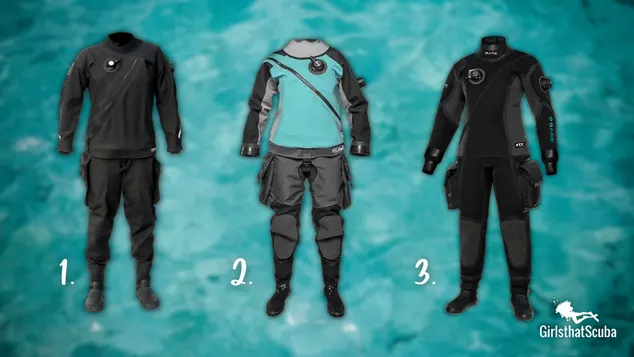
However, in warmer locations, you can use a semi-dry wetsuit instead. If you do, you’ll probably want a cosy pair of gloves and dive boots to go with it. And don’t forget a hood, if the suit doesn’t come with one attached.
If you’re not sure whether to dive in a drysuit or a semi-dry suit, try asking local divers what they use.
Knife or Cutting Tool
When diving in freshwater environments, you’ll encounter some incredible plant species. This is part of what makes freshwater diving so great, but it poses hazards too.
You can become entangled in plants that grow long and tall (similar to kelp forests). So, it’s a good idea to take a knife or cutting tool with you when altitude diving.
If you’re buying new gear, why not get used to it in a familiar diving environment first? For some people, this might be in a protected, shallow bay area, or a local quarry. For others, it might be at a local training pool.
Is altitude diving dangerous?
Diving at altitude comes with an increased risk of decompression sickness, which is why specialist training is required. But, if you remember your training, it can be perfectly safe.
However, there are some additional risks associated with spending time in high-altitude or very cold environments. These include:
Altitude Sickness
This occurs when you travel to a high altitude too quickly. Symptoms can include headache, dizziness, and shortness of breath.
This typically doesn’t occur at altitudes lower than 2,400 meters (8000 feet). However, it’s always a good idea to give your body some time to acclimatise before diving.
Hypothermia
This occurs when your body temperature drops to dangerous levels (below 35°C/95°F). This typically occurs when you’re exposed to cold temperatures for too long.
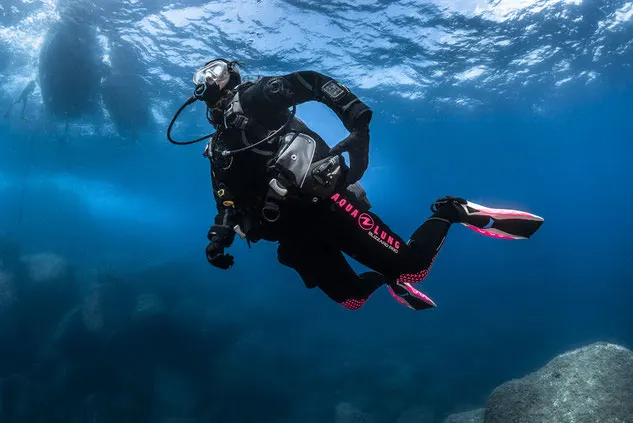
Even the best drysuit can leak sometimes, or your vehicle may break down causing you to spend half a day on a mountainside after a frosty dive.
A thermos of hot water and a foil blanket can make all the difference at times like these – so always take them with you.
General First Aid
As scuba divers, most of us are already aware of the dangers of carrying out physical activities in remote areas. Altitude diving is no different.
If you think you’ll be spending lots of time up a remote mountainside, then why not take a course and brush up on your first aid skills? Taking your Rescue Diver course before your altitude training could also be beneficial.
Where can I go altitude diving?
Ready to book your next altitude diving adventure? Great! Here are some of the best places to altitude dive:
Yellowstone National Park, USA
In the summer months of July and August, Yellowstone National Park is transformed into a haven for altitude divers. It’s a little warmer, and the visibility can be up to 10m (30 feet).
What’s more, there are plenty of underwater fissures, hot water vents, and even wrecks for you to explore. Yellowstone Lake is particularly popular and is located a whopping 2,372m (7,783 feet) above sea level.
Walchensee, Germany
You can find this vast alpine lake 800m (2,600 feet) above sea level. It’s one of the most enchanting lakes in Germany, and its glassy waters host a range of underwater species.
Caumasee, Switzerland
Rather than being filled by a river or the falling of rain, this quirky lake is fed via underground sources. It’s located approximately 1,000m (3,200 feet) above sea level and is surrounded by beautiful alpine forest.
Lake Atitlán, Guatemala
The deepest lake in Central America (335m or 1100 feet deep) is definitely one to add to your altitude diving bucket list. The lake sits at 1562m (5125 feet) altitude and offers an array of dive sites to explore, from plummeting walls to cavernous swimthroughs. Plus there aren’t many dives where you can surface between three active volcanos!
Are you considering altitude diving, or an experienced altitude diver with stories to share? Join our Girls that Scuba Facebook community and share with tens of thousands of like-minded women divers!

About the Author
Rose has spent the last few years living in Europe, the Seychelles and Kenya, working as a dive instructor, writer and conservationist. She’s back in the UK at the moment and is slowly acclimatising to cooler waters!

